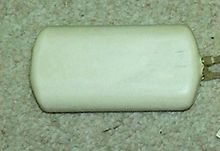- Noel Desmond Gray
-
Noel Desmond Gray (26 December 1920 – November 1999) was an Australian technician, co-founder and initial financier of the medical electronics company Telectronics Pty Ltd.[1]
Contents
Early life
Gray was born to Hilda Alice Gray and Joseph Albert Gray on Boxing Day 1920 in Crookwell, New South Wales, Australia. He was the great grandson of George H. Hedger who may have been the inspiration for the Banjo Patterson poem "The Man from Snowy River".[2] Gray grew up for a time on his grandfather's farm "Middle View" named for its view of the Snowy River near Dalgety.
He attended Sydney Technical School and after passing the Intermediate Certificate he was employed as a wirer for radio manufacturers AWA Australia and then Kreisler Australasia.[citation needed]
World War II
Gray enlisted in the army in August 1942.[3] During World War II he was trained at the Army School of Radio Physics, whereupon he became a radar technician and Senior Radar Artificer. He also attended No. 6 OCTU (Officer Cadet Training Unit) but was denied a commission after failing an associated engineering course.
Gray returned to LHQ where he was placed in charge of the Drawing Office and maintenance section. He helped to install the radar defenses on Rottnest Island for Western Australia and was the Senior Radar Artificer at Exmouth Gulf.[4] He worked on the first US-designed RADAR unit in Australia, which was subsequently used to direct bombers during the Battle of the Coral Sea.[1]
Gray was discharged from the army on 10 May 1946 with the rank of Staff Sergeant posted to 2 SPECIAL RADAR DET RAA.[3]
Post war
In 1948 Gray was accepted to study medicine at the University of Sydney but withdrew from his studies in 1950 to work for the Department of Civil Aviation on RADAR installation at Sydney Airport, and on engineering projects for the Metropolitan Water, Sewerage & Drainage Board.
In 1952 he returned to work for the Philips' subsidiary Kreisler. He designed and developed printed circuit boards that were used in a production run of Kriesler Duplex radios. A number of patents were taken out on his work.[1]
Gray resigned from Kreisler in 1959 to start a medical electronics business, an ambition he had developed while studying medicine in 1948.[1] To finance this venture he started a specialist TV repair business[5] and was a founder of ESA (later called TESA).[1]
Telectronics
Telectronics Pty Limited was incorporated in Sydney, Australia, in 1963[1][6] by Gray and engineer Geoffrey Wickham initially designing and manufacturing industrial and scientific instruments but diversifying into medical electronics and commencing cardiac pacemaker research in 1964.[7][8] The corporate name was derived from "Television and Electronic Services", operated by Noel Gray as a sole trader from 1959-1964.[1]
The company made significant contributions to pacemaker technology including the first definition of the relationship between surface area of the heart electrodes & pacing pulse characteristics, the first use of integrated circuits and the first hermetic titanium encapsulation.[1][6]
The private company Nucleus became a 50% shareholder of Telectronics in January 1968 following the informal participation by Paul M Trainor of Nucleus in management of Telectronics in 1967[requires reference] when the company was facing bankruptcy.[requires reference] In 1975 the holding by Nucleus was reduced by sale of shares to a French multinational leaving a 33.33% holding by Nucleus Corporation Pty Ltd which became the publicly listed company Nucleus Limited 1980. In turn Nucleus Limited was acquired by Pacific Dunlop in 1988. Legal action over the sale of faulty "J Lead" electrodes, inherited by Telectronics in acquisition of pacemaker manufacturer Cordis corporation of Miama led to the company having to settle extensive worldwide compensation claims. This led to the sale of Telectronics assets to, eventually, St Jude Medical of Minneapolis and Pacific Dunlop restructuring itself into Ansell.[citation needed]
Death
Noel Desmond Gray died in November 1999. He was survived by his wife Beth, daughter Robyn, and son Christopher.
References
- ^ a b c d e f g h Gray, Christopher & Gray, Noel (1993). The Early Years of Telectronics. (self-published). ISBN 0646151347. http://books.google.com/books?id=OAZZAQAACAAJ&dq.
- ^ "Death of George H. Hedger". Monaro Mercury. 3 August 1912.
- ^ a b "Listing for Noel Desmond Gray". World War II nominal roll. Australian Government - Department of Veterans' Affairs. http://www.ww2roll.gov.au/script/veteran.asp?ServiceID=A&VeteranID=210360. Retrieved 1 May 2008.
- ^ Dunn, Peter. Peter Dunn's Australia at War.
- ^ Mingay's Weekly, 27 November 1959
- ^ a b "Telectronics and The History Of Pacemaking In Australia", Wickham G G, Jeffcoat KW, 1987 manuscript held by http://www.austehc.unimelb.edu.au. University Of Melbourne .(www.austehc.unimelb.edu.au.)
- ^ Foot, Robert (14 April 2006). "Rare breed of native industrialist: Paul Murray Trainor, AO Industrialist 1927-2006". Obituaries (Sydney Morning Herald). http://www.smh.com.au/news/obituaries/rare-breed-of-native-industrialist/2006/04/13/1144521458280.html?page=fullpage#contentSwap1. Retrieved 4 December 2006.
- ^ "Display panels tracing the history of 'Telectronics' cardiac pacemakers and defibrillators, 1990". Objects from the collection of the Powerhouse Museum, Sydney, Australia. Powerhouse Museum. http://www.powerhousemuseum.com/collection/database/?irn=331255. Retrieved 4 December 2006.
Categories:- 1920 births
- 1999 deaths
- Australian businesspeople
- People associated with radar
Wikimedia Foundation. 2010.

